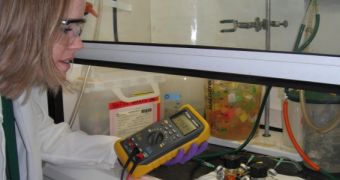A group of investigators from the NASA Jet Propulsion Laboratory (JPL) in Pasadena, California, was able to demonstrate in a new study that fuel cells can be used as an approximation of the earliest chemical conditions on Earth. This implies that scientists can potentially use these devices to study the emergence of life in the inhospitable, toxic environments that existed here billions of years ago.
While researchers have some clues about the factors that must have contributed to the development of life, the exact processes, phenomena and locations involved in this long-term process remain mysterious to this day. Thus far, these conditions have only been simulated in test tubes in the lab, but the JPL-led team argues that fuel cells may provide a better approximation of what went on.
The investigation was led by JPL scientist Laurie Barge, and is detailed in a paper published online in the March 13 issue of the esteemed journal Astrobiology. Barge explains that fuel cells are similar to batteries, in that they produce electricity, but differ from the latter through the fact that they need fuel to operate, such as microbes that convert waste to power, or hydrogen gas.
What the researchers are proposing in this research is using fuel cells not as a source of power, but as a small-scale chemical laboratory for testing reactions that might have led to the development of life on the early Earth. Barge is also a member of the JPL Icy Worlds team with the NASA Astrobiology Institute, which is based at the NASA Ames Research Center (ARC) in Moffett Field, California.
“Something about Earth led to life, and we think one important factor was that the planet provides electrical energy at the seafloor. This energy could have kick-started life – and could have sustained life after it arose. Now, we have a way of testing different materials and environments that could have helped life arise not just on Earth, but possibly on Mars, Europa and other places […],” she says.
Fuel cells, Barge explains, are very similar to biological cells, in that they transfer electrons from one molecules to another, through a process akin to metabolism. In our bodies, this phenomenon is responsible for giving us energy, and allowing us to function properly throughout the day.
The setup used in the new study featured fuel cell electrodes and catalysts made up of primitive geological materials, which researchers believe permeated Earth around 4 billion years ago. The goal was to see whether or not these materials were able to circulate electrons, a process that would have been evidenced by the production of a small amount of electricity.
By experimenting with these fuel cells, researchers slowly narrow down the array of chemical conditions that favored the development of life. “What we are proposing here is to simulate energetic processes, which could bridge the gap between the geological processes of the early Earth and the emergence of biological life on this planet,” explains researcher Terry Kee.
The expert is one of the coauthors of the new paper, and is based at the University of Leeds, England.
“We're going back in time to test specific minerals such as those containing iron and nickel, which would have been common on the early Earth and could have led to biological metabolism,” Barge concludes.

 14 DAY TRIAL //
14 DAY TRIAL //